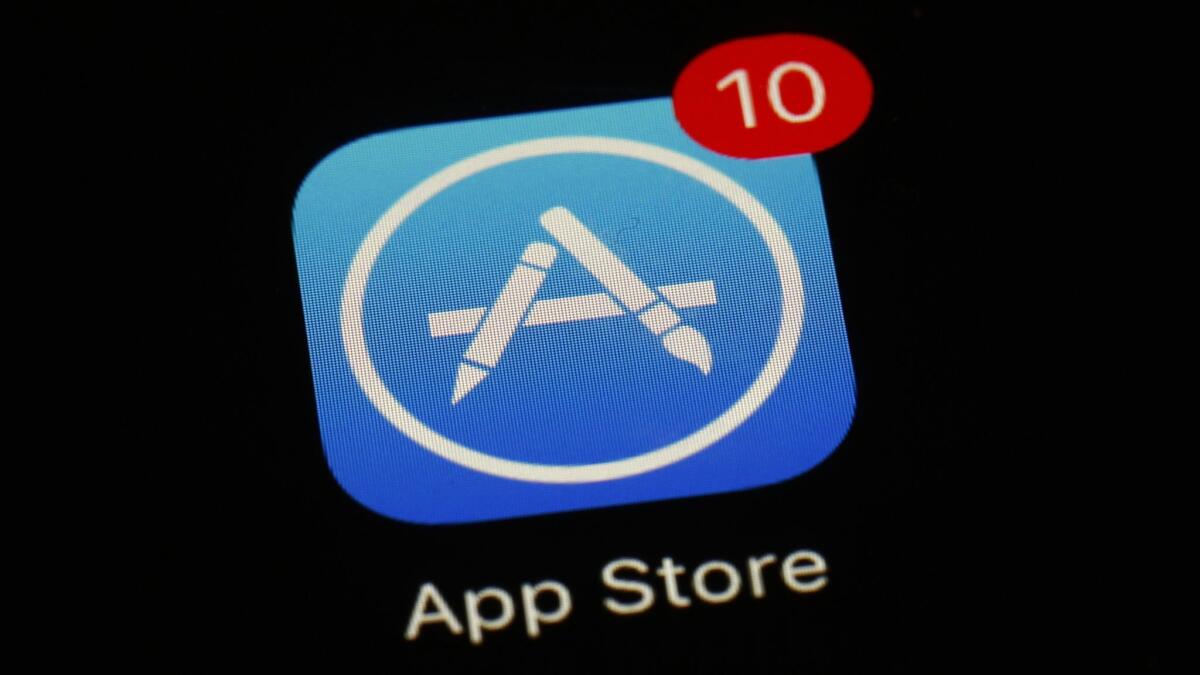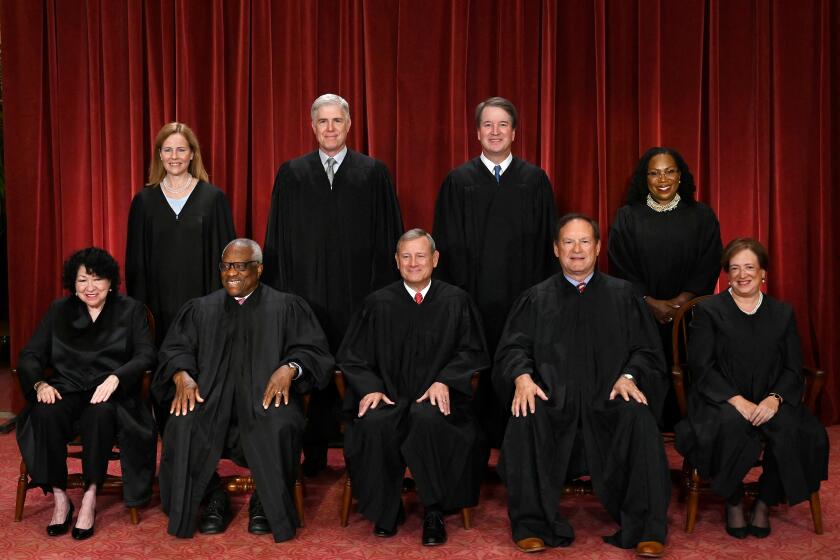Supreme Court rules Apple can face antitrust suits from iPhone owners over App Store sales

- Share via
Reporting from Washington — The Supreme Court gave a boost to antitrust laws in the digital era as it cleared the way Monday for Apple to be sued for allegedly monopolizing the sale of apps on its iPhones.
Justice Brett M. Kavanaugh, joined by the court’s four liberal justices, rejected Apple’s defense that it could not be sued over the price of apps because it simply offered a platform for others to sell their products.
That ruling potentially opens the way for similar lawsuits against other giant tech platforms that have a business model similar to Apple’s, legal experts said.
“Today’s decision unquestionably opens the door to consumer claims against a wide range of digital platforms that use their market power to their advantage,” said Deepak Gupta, a Washington lawyer who represented the Open Markets Institute in the case. “Going forward, this is going to be a significant ruling for the big platforms — from Apple to Amazon.”
Much of corporate America had joined in support of Apple and argued that such broad antitrust claims should be blocked at the starting gate. So did the Trump administration.
The plaintiffs in the case, Apple vs. Pepper, alleged that “Apple locks iPhone users into buying only from Apple” and takes a 30% commission on all app sales, Kavanaugh noted. They argued that, as a result, apps cost more than they would if Apple did not control the sales.
“Ever since Congress overwhelmingly passed the Sherman Act of 1890, protecting consumers from monopoly prices has been the central concern of antitrust. That is why we have antitrust law,” Kavanaugh wrote. The consumers who sued “purchased apps directly from Apple,” the jurist added. And the antitrust laws protect “any person” who pays too much because of an anti-competitive conspiracy. That is enough for the suit to proceed, he said, even though it did not mean the plaintiffs would finally prevail.
If the plaintiffs do prevail, the suit could lead to a huge verdict or settlement. The case potentially involves an extraordinary number of plaintiffs, and Apple’s sales of services, including the App Store, run to tens of billions of dollars a year.
Apple said it expected to win in the end.
“We’re confident we will prevail when the facts are presented and that the App Store is a not a monopoly by any metric,” the company said in a statement. “We’re proud to have created the safest, most secure and trusted platform for customers and a great business opportunity for all developers around the world. Developers set the price they want to charge for their app, and Apple has no role in that.”
Dan Ives, equity analyst at Wedbush Securities, said Apple’s store services had been key to the company’s growth. Apple has seen net sales of its services, including the App Store, grow from roughly $24 billion in 2016 to $37 billion in 2018.
“This opens up Pandora’s box,” he said. “It’s never a good thing for a tech titan like Apple to be walking into the Supreme Court with a ruling that could have implications for the App Store for years to come. Especially with the dreaded M word being used — ‘monopoly.’ ”
In 2007, Apple started selling iPhones. And the next year, Apple launched the App Store, where, as the court noted, iPhone users can purchase apps “to send messages, take photos, watch videos, buy clothes, order food or arrange transportation.”
“ ‘There’s an app for that’ has become a part of the 21st century American lexicon,” Kavanaugh said.
The antitrust lawsuit began in 2011. Initially, a federal judge in Northern California ordered it dismissed on the grounds that purchasers of iPhone apps had no antitrust claim against Apple. But the 9th Circuit Court of Appeals, in a 3-0 opinion, revived the claim and allowed the suit to proceed on the grounds that consumers were “direct purchasers” of apps from Apple and might have been forced to pay monopoly prices.
Apple “sells the apps and adds a 30% commission,” Judge William Fletcher wrote for the 9th Circuit. It “is a distributor of the iPhone apps, selling them directly to purchasers through its App Store.” As such, the plaintiffs have standing “to sue Apple for allegedly monopolizing and attempting to monopolize the sale of iPhone apps.”
Apple’s new TV app lets users download this season’s ‘Game of Thrones’ episodes »
Lawyers for Apple had told the justices that the company was like the owner of a shopping mall, which could not be held liable for monopoly prices charged by one or more of the retail stores.
The company relied on a Supreme Court precedent from 1977 that said only “direct purchasers” could sue a company under the antitrust laws. This meant, for example, a consumer could sue a retailer, but not a wholesaler or a manufacturer of a product.
When the justices heard arguments in the case in November, most of them sounded skeptical of tossing out the antitrust claim entirely based on legal precedents set during the industrial era.
But the justices were closely split in the final decision on the question of whether consumers were buying directly from Apple or indirectly when they made purchases through the App Store.
The opinions in the case displayed a split between President Trump’s two appointees to the court, with Kavanaugh writing for the majority and Justice Neil M. Gorsuch writing the dissent.
Kavanaugh said consumers were buying directly from Apple and possibly paying too much.
“IPhone owners purchase apps directly from the retailer Apple, who is the alleged antitrust violator. The iPhone owners pay the alleged overcharge directly to Apple,” he wrote. “We decline to green-light monopolistic retailers to exploit their market position in that way.”
Justices Ruth Bader Ginsburg, Stephen G. Breyer, Sonia Sotomayor and Elena Kagan signed onto his opinion.
In dissent, Gorsuch said the majority was misinterpreting the 1977 decision, known as Illinois Brick. In that case, the justices said the state of Illinois could not sue over the high price of construction projects because brick makers had allegedly conspired to fix prices. Only direct purchasers of bricks could sue.
Gorsuch and the dissenters said the majority in the Apple case failed to grapple with the “economic reality” of the transactions.
“The problem is that the 30% commission falls initially on developers. So if the commission is in fact a monopolistic overcharge, the developers are the parties who are directly injured by it” and they should be the ones entitled to sue, Gorsuch wrote. App developers might pass Apple’s 30% commission along to consumers, but they might not, he noted. Chief Justice John G. Roberts Jr. and Justices Clarence Thomas and Samuel A. Alito Jr. agreed.
More stories from David G. Savage »
More to Read
Get the L.A. Times Politics newsletter
Deeply reported insights into legislation, politics and policy from Sacramento, Washington and beyond. In your inbox twice per week.
You may occasionally receive promotional content from the Los Angeles Times.












